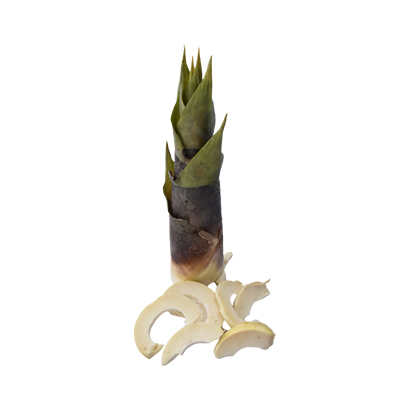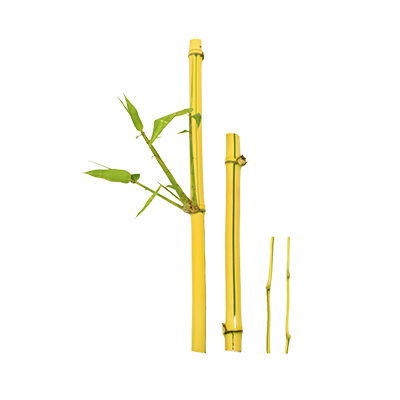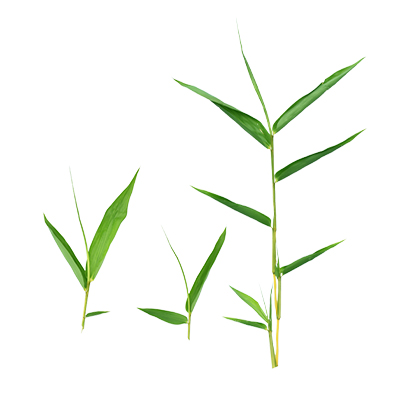Golden Bamboo
Bambusa vulgaris Schrad. ex J.C. Wendl.
Poaceae
Location in our garden
Aquatic
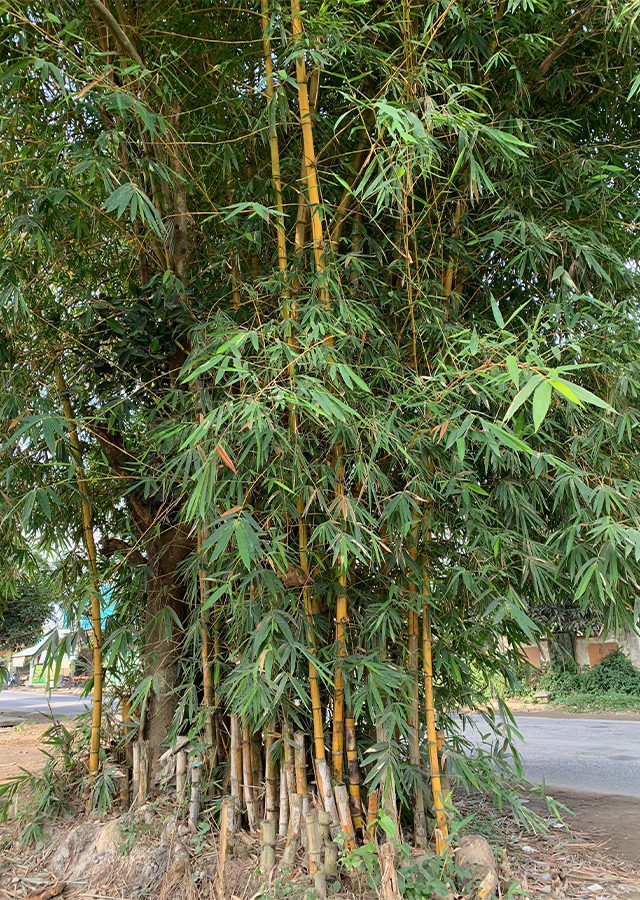
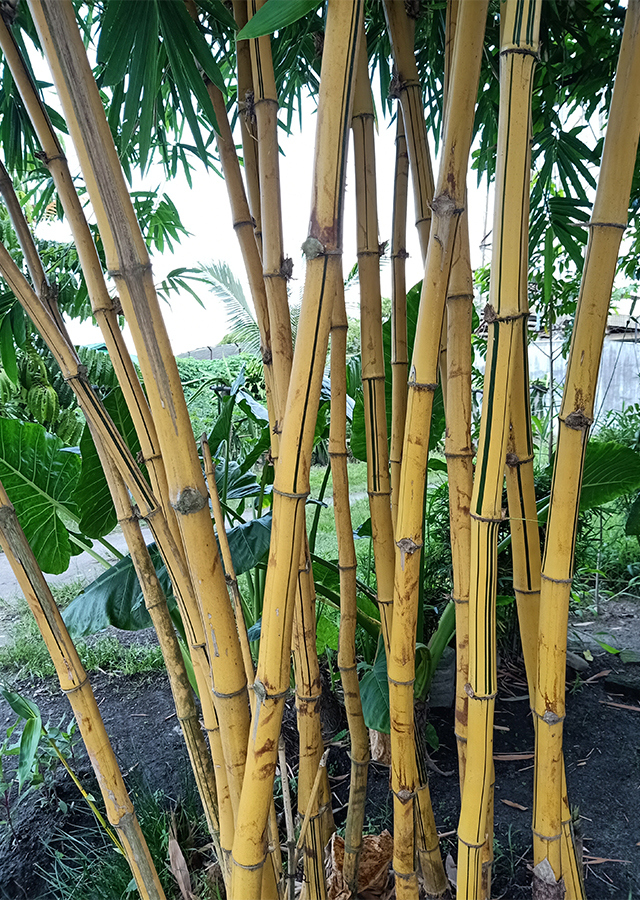
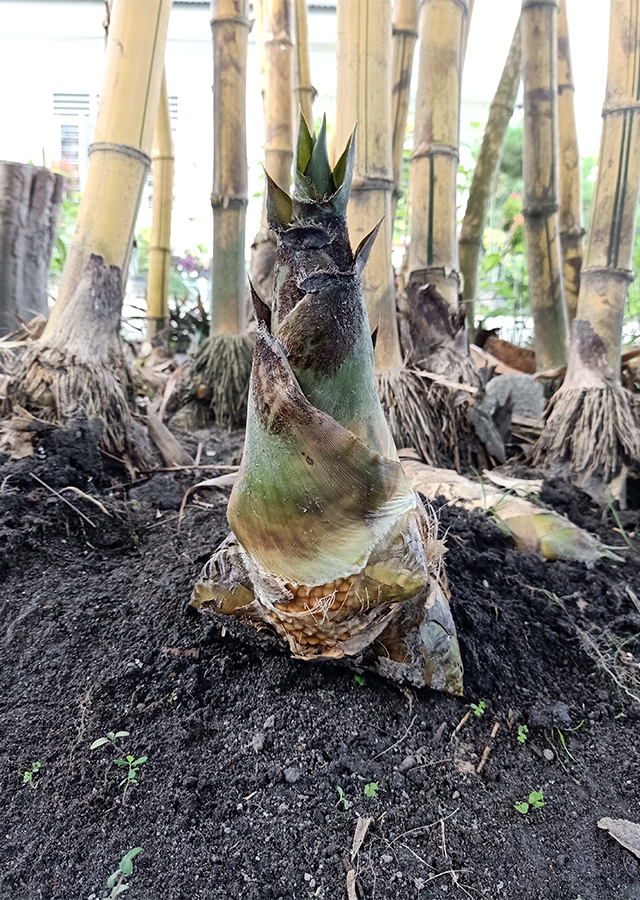
Synonym
Arundarbor blancoi (Steud.) Kuntze
Bambusa auriculata Kurz
Gigantochloa auriculata (Kurz) Kurz
Habitus
Bamboo. Sympodial bamboo,culm erect, evergreen, clump-forming bamboo, grows up to 15-20 m tall, 4-10 cm in diameter, internodes 20-45 cm long, with appressed dark hairs and white waxy when young, becoming glabrous, smooth and shiny with age.
Part Used
Shoots
Leaves
Bark
Stem
Young Shoot
Growing Requirements
Full Sunshine
High Rainfall
Habitat
Riverbanks
Forest
Overview
Golden bamboo originated in the Old World, possibly in tropical Asia. It is the most commonly cultivated bamboo in the tropics and subtropics, but it is naturally found or naturalized on river banks. It is the most common cultivated bamboo in South-East Asia, found everywhere in villages, on river banks, and as an ornament in cities.
Vernacular Names
Golden bamboo (English), Bambu kuning/ yellow culms (Indonesia), Bariala (Bangladesh), Long tou zhu (Chinese), Bois bambou (French), Bakal (India), Tamelang (Malay), Butong (Philippines), Phai-luang (Thai).
Agroecology
Bambusa vulgaris often naturally occurs or naturalized on river banks, roadsides, wastelands and open ground in areas with annual precipitation ranging from 1,500 to 3,800 mm and in well-drained soils with pH ranging from 4.5 to 7.5. usually at low altitudes (below 1,200 m altitude). It grows under a wide variety of environmental conditions, growing along rivers and lakes in almost permanently wet conditions.
Morphology
- Stems - slightly zig-zag, wall 7 - 15 mm thick, glossy green,yellow, or yellow with green stripes, nodes oblique, slighly swollen.basal ones covered with aerial roots. Braches arising from midculm nodes upward, occasionaly also at lower nodes. Culm sheath more or less broadly triangular, 15 - 45 cm x 20 cm, upper ones longest.
- Leaves - blade, 6-30 cm long, 1-4 wide, glabrous; ligule a subentire rim 0.5-1.5 mm; auricles small rounded lobes, with a few bristles 1-3 mm.
- Flowers - usually borne on a leafless branch of a leafless culm or on a culm with small leaves, bearing small groups of pseudospikelets at the nodes, 2-6 cm apart; spikelets 12-19 (-35) mm long, laterally flattened, appearing strongly 2-cleft, comprising 5-10 perfect florets and a terminal vestigial floret.
Cultivation
Vegetative propagation of this plant is by clump division, by rhizome, stem and branch cuttings, by layering and by tissue culture. Stem or branch cuttings are the simplest and most practiced propagation technique.
Chemical Constituents
Flavonoids, phytosterol, phitophenol, holocellulose, alpha cellulose, lignin, phenolic acid, lactones, triterpenoid, alkaloids.
Traditional Medicinal Uses
- The stems are used as a rheumatism treatment.
- Shoots are used to treat malaria and abscesses.
- The bark is astringent and emmenagogue.
- Chloroform leaf extract is used against mycobacterium tuberculosis.
- Tabasheer is used to prevent infantile epilepsy, fever and hematuria, kidney problems, bark astringent and emmenagogue (to induce or improve menstrual flow), and as an abortifacient.
- The leaves are used to treat problems with the heart and malaria. They are boiled and used to relieve fevers in a bath.
- Women use a decoction of boiled leaves as a 'clean-out' for dilation and curettage and help remove the afterbirth.
- In treating a fever, the leaves are boiled like hot tea, which causes profuse transpiration.
- The sap is used to treat hematuria and fever.
- It is used in the treatment of various inflammatory disorders in Indian folk medicine.
- For anti-fertility effects in India, leaves extract is taken orally to decrease sperm count.
Part Used
Reference Sources
- CABI. (No date). Invasive Species Compendium. Bambusa vulgaris (common bamboo). https://www.cabi.org/isc/datasheet/8398. 03-12-2020.
- Guadua Bamboo. (No date). Bambusa vulgaris. https://www.guaduabamboo.com/blog/bambusa-vulgaris. 03-12-2020.
- Stuartxchange. (2018). Philippine Medicinal Plants. Kauayan-kiling http://www.stuartxchange.org/Kauayan-kiling. 03-12-2020.
- Fern, Ken. (2019). Useful Tropical Plants: Bambusa vulgaris. http://tropical.theferns.info/viewtropical.php?id=Bambusa+vulgaris. 17-03-2021.
- Dransfield S, Widjaja EA, (Editors), 1995. Plant resources of South-East Asia No. 7. Bamboos. Backhuys Publishers, Leiden. 189 pp. 12 Oktober 2021.
